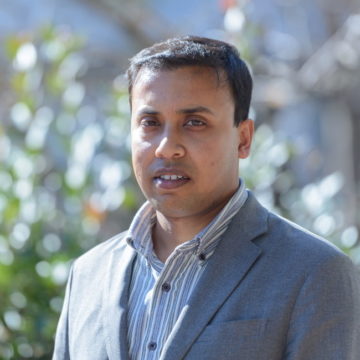
材料・デバイス研究
Debraj Chandra
特任准教授(PI)
Nanomaterials Heterogeneous Catalysis Photocatalysts
略歴
Dr. Debraj Chandra did PhD, 2008 in Materials Science at Indian Association for the Cultivation of Science (IACS), India. Currently, he worked as a Specially Appointed Associate Professor at World Research Hub Initiative (WRHI), Tokyo Institute of Technology, Japan. He came Japan as a Postdoctoral Researcher at National Institute of Advanced Industrial Science and Technology (AIST), 2008-2011. He worked under various JSPS Fellowship (Standard and Pathway) in Niigata University, Japan, 2011-2016. He joined as an Assistant Professor at Tokyo Institute of Technology in 2016. His research interest includes development of nanoarchitectures of porous metal oxides and metal nanoparticles based materials, having novel structural, surface and electronic properties and their application in heterogeneous catalysis for production of value-added chemicals, solar water splitting and electrocatalysis.
WRHIへの期待
As a researcher in the Tokyo Tech World Research Hub Initiative (WRHI), Dr. Debraj Chandra is expecting to promote cutting-edge interdisciplinary research by utilizing attractive and world-class research environment of Tokyo Tech; as well as through active international collaboration with some leading materials research laboratories of other countries, according to the aspiration of the present WRHI program.
研究プロジェクト
-
Shape-specific metal nanoparticles as high performance catalyst for selective reductive amination
-
Creation of first organized mesoporous WO3 photoanodes for highly efficient visible-light-driven water oxidation
トピックス
-
研究紹介ビデオ公開
-
2018 Tokyo Tech News and Chemical Industry Daily report (July 3, 2018) has published the work of “High performance catalyst of shape-specific ruthenium nanoparticles for production of primary amines”. A paper published in Chemical Science.
-
2010 AIST Homepage and two newspapers of Japan named as Nikkan-kougyo-shinbum and Kagaku-kougyo-nippou (September 16, 2010) has highlighted the work of “Dye-sensitized bio-system sensing by porous semiconducting metal oxide films”. A paper published in J. Mater. Chem.
| 2017- |
Specially Appointed Associate Professor, WRHI, IIR, Tokyo Institute of Technology |
|---|---|
| 2016-2017 |
Specially Appointed Assistant Professor, WRHI, IIR, Tokyo Institute of Technology |
| 2011-2016 |
JSPS Fellow (Standard and Pathway), Niigata University, Japan |
| 2008-2011 |
Postdoctoral Researcher, AIST Japan |
| 2003-2008 |
PhD, Indian Association for the Cultivation of Science (IACS), India |
| 2020 |
“Electronic effect in a ruthenium catalyst designed in nanoporous N-functionalized carbon for efficient hydrogenation of heteroarenes”, Debraj Chandra, Shikha Saini, Saswata Bhattacharya, Asim Bhaumik, Keigo Kamata and Michikazu Hara, ACS Applied Materials & Interfaces (2020, in press) DOI: 10.1021/acsami.0c15407 |
|---|---|
| 2018 |
“A high performance catalyst of shape-specific ruthenium nanoparticles for production of primary amines by reductive amination of carbonyl compounds”, D. Chandra, Y. Inoue, M. Sasase, M. Kitano, A. Bhaumik, K. Kamata, H. Hosono, M. Hara, Chemical Science, 9 (2018) 5949-5946. |
| 2016 |
“Highly efficient electrocatalysis and mechanistic investigation of intermediate IrOx(OH)y nanoparticle films for water oxidation”, D. Chandra, D. Takama, T. Masaki, T. Sato, N. Abe, T. Togashi, M. Kurihara, K. Saito, T. Yui, M. Yagi, ACS Catalysis, 6 (2016) 3946-3954. |
| 2015 |
“Open pore architecture of an ordered mesoporous IrO2 thin film for highly efficient electrocatalysis for water oxidation”, D. Chandra, N. Abe, K. Saito, T. Yui, M. Yagi, ChemSusChem, 8 (2015) 795-799. |
| 2013 |
“Crystallization of tungsten trioxide having small mesopores: Highly efficient photoanode for visible-light-driven water oxidation”, D. Chandra, K. Saito, T. Yui, M. Yagi, Angew. Chem. Int. Ed., 52 (2013) 12606-12609. |
| 2011 |
“Dye-sensitized bio-system sensing using macroporous semiconducting metal oxide films”, D. Chandra, M. Bekki, M. Nakamura, S. Sonezaki, T. Ohji, K. Kato, T. Kimura, J. Mater. Chem., 21 (2011) 5738-5744. |
| 2007 |
“Highly luminescent organic-inorganic hybrid mesoporous silicas containing tunable chemosensor inside the pore wall”, D. Chandra, T. Yokoi, T. Tatsumi, A. Bhaumik, Chem. Mater., 19 (2007) 5347-5354. |
| 2007 |
“Functionalized mesoporous cross-linked polymer as efficient host for loading gold nanoparticles and its electrocatalytic behavior for reduction of H2O2”, D. Chandra, B. K. Jena, C. R. Raj, A. Bhaumik, Chem. Mater., 19 (2007) 6290-6296. |
